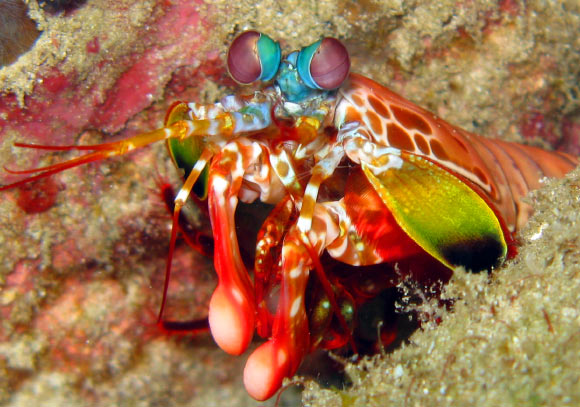New research conducted by an international team of marine biologists reveals that the mantis shrimp Haptosquilla trispinosa uses a unique color vision system.
Most mammals have two types of photoreceptors – cells that convert light into electrical signals – in their eyes. Humans and many other primates have three; some birds and reptiles have four photoreceptors. Certain butterflies can even have six. But the mantis shrimp has 12 different types of photoreceptors in their eyes – and scientists haven’t understood why until now.
Previous studies have shown that four to seven photoreceptors are enough for animals to see every color under the Sun.
The study, published in the journal Science, crushes the illusion that complex eyes with more color channels mean better color vision.
“Theoretically, mantis shrimp should be far better at distinguishing colors than we are. Human brains – and all other animals including birds, monkeys, frogs and fish – determine the colors of objects by comparing the relative excitation of inputs. For instance, in humans this is red, green and blue. The critical finding is that mantis shrimp do not do this, and this means their way of encoding color is different to all other animals known,” said study lead author Ms Hanne Thoen from the University of Queensland in Brisbane, Australia.
Ms Thoen with colleagues conducted a number of tests, including training the mantis shrimps to respond to certain colors and using a two-way choice test with food as a reward. By receiving food when choosing one particular color and not any other, the shrimp quickly learned which choice to make and also revealed how they encode color.
“We tested their ability to discriminate between colors that differ a lot – such as red and blue – and then changed to colors that got closer and closer together along the spectrum – red-green, red-yellow, red-orange – and noted when they started to make mistakes,” Ms Thoen said.
“Results were also compared to a number of other animals, including humans, bees, fish and butterflies, and although theoretically they should be better than all of them, they are far worse.”
The study solves a long-standing problem of why mantis shrimp have 12 color receptors – because they process colors and the contrast they provide in a totally different way to anything we have previously seen in an animal.
“This is the first time since the original descriptions of color vision in the 1800s that we are able to say that there is another way of color processing out there,” Ms Thoen said.
The discovery would stimulate and inspire the advancement of new and innovative technologies in the applied sciences.
“Modern cameras struggle with the amount of data they take in due to increased pixel numbers. Maybe there is a more efficient way and the bio-inspiration provided by the shrimp could be the answer,” Ms Thoen concluded.
______
Thoen HH et al. 2014. A Different Form of Color Vision in Mantis Shrimp. Science, vol. 343, no. 6169, pp. 411-413; doi: 10.1126/science.1245824








